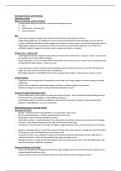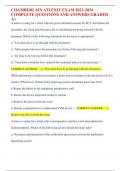Exchange surfaces
Why are exchange systems needed?
- 3 main factors affect the need for a specialised exchange system:
1. Size
2. Surface area : volume ratio
3. Level of activity
Size
- Cells need a supply of oxygen and nutrients and to remove toxic waste to survive
- Single-celled organisms: all cytoplasm is close to external environment and exchange can occur all over
surface so diffusion supplies enough oxygen and nutrients to keep it alive = no need for specialised system
- Multicellular organisms: many layers of cells so the surface is not efficient, diffusion is too slow for a
sufficient supply of oxygen to innermost cells = specialised system is needed
Surface area : volume ratio
- Small organisms have a relatively large surface areas to their small volume = large sa:v ratio = surface area
can supply all cells with sufficient oxygen
- Larger organisms: as size increases volume rises faster than surface area, so surface area is relatively small
compared with large volume = small sa:v ratio
- Some organisms increase surface area by changing shape e.g. flatworms have a very thin, flat body for a
larger sa:v ratio, but this limits the size it can grow to
- Most large organisms need different tissues for support and strength = large volume, small sa:v ratio
Level of activity
- Organisms have varying levels of metabolic activity that uses energy oxygen to release energy in aerobic
respiration
- Cells of active organisms need good supplies of these to release energy for movement
- Need for energy is increased in animals that keep themselves warm
Features of a good exchange surface
- Large surface area = more space for molecules to pass through – often achieved through folding surfaces
- Thin barrier that is permeable to reduce diffusion distance
- Good blood supply to bring fresh supplies of molecules on one side to maintain a high concentration
gradient = rapid diffusion can occur constantly
Mammalian gaseous exchange system
Overview of system
- Alveoli = tiny folds of the lung epithelium to increase the surface area
- Bronchi and bronchioles = smaller airways leading to the lungs
- Diaphragm = layer of muscle beneath the lungs
- Intercostal muscles = muscles between ribs, contraction of external intercostal muscles raise the ribcage
- Trachea = main airway leading from the back of the mouth to the lungs
- Ventilation = refresh of air in the lungs, for higher oxygen and lower CO2 concentration than in the blood
- Gaseous exchange system in mammals consists of lungs and various airways carrying air to and from them
- The lungs are a pair of inflatable sacs in the chest cavity
- Air passes into the nose, along the trachea, bronchi and bronchioles and finally into the lungs where is
reaches the alveoli – these are the surfaces where gas exchange occurs
- Ribcage protects the lungs and are held together by intercostal muscles which, with the diaphragm, help
create movements needed for ventilation
Gaseous exchange in the lungs
- Gases pass by diffusion through the thin alveoli walls: oxygen from air in alveoli to blood in capillary, and
carbon dioxide from blood to air
- Lungs maintain a steep concentration gradient in both directions for exchange to continu
, Surface area - alveoli
- Individual alveoli are very small – 100-300µm diameter
- So many of them that overall the surface area of lungs is 70m2 (larger than our skin)
- Alveoli are lined by a thin layer of moisture which evaporates and is lost when we exhale
- The lungs need to produce a surfactant that coats the internal alveoli surface to reduce the cohesive
forces between water molecules, as these forces would make the alveoli collapse
Barrier to exchange
- The barrier to exchange = alveolus wall + blood capillary wall
- The cells’ plasma membranes readily allow diffusion of O2 and CO2 as they are small, non-polar molecules
Diffusion distance
- Numerous adaptations to reduce the diffusion distance so the total barrier to diffusion is only 2 flattened
cells, less than 1µm thick in total
1. Alveolus and capillary walls are each one cell thick
2. Both walls have squamous cells (flattened or very thin)
3. Capillaries in close contact with alveolus walls
4. Capillaries very narrow so red blood cells are squeezed against the wall = closer to air in alveoli and
reduces their rate of flow
Blood supply
- Blood supply helps to maintain a steep concentration gradient so that the gases continue to diffuse
Blood system transport: Carbon dioxide from tissues to lungs Oxygen away from lungs
This ensures that: Carbon dioxide concentration in blood is higher than Oxygen concentration in blood is lower than
in alveoli, so it diffuses out of the blood in alveoli, so oxygen diffuses into the blood
Ventilation
- Breathing movements ventilate the lungs to replace the used air with fresh air, bring in more oxygen and
removing carbon dioxide
- Ventilation ensures that:
1. Concentration of oxygen in air in alveolus is higher than the blood
2. Concentration of carbon dioxide in air in alveolus is lower than in the blood
Inspiration (inhaling) Expiration (exhaling)
Diaphragm Contracts, moves down, becomes flatter, Relaxes, moves up, pushed up by displaced
displaces digestive organs beneath organs beneath



